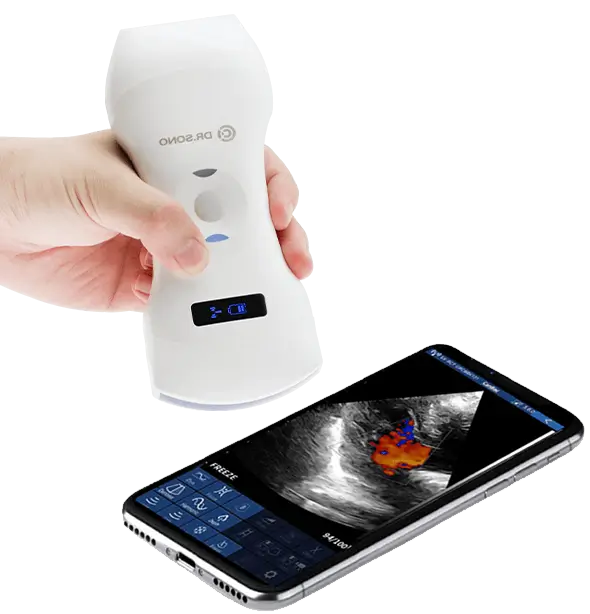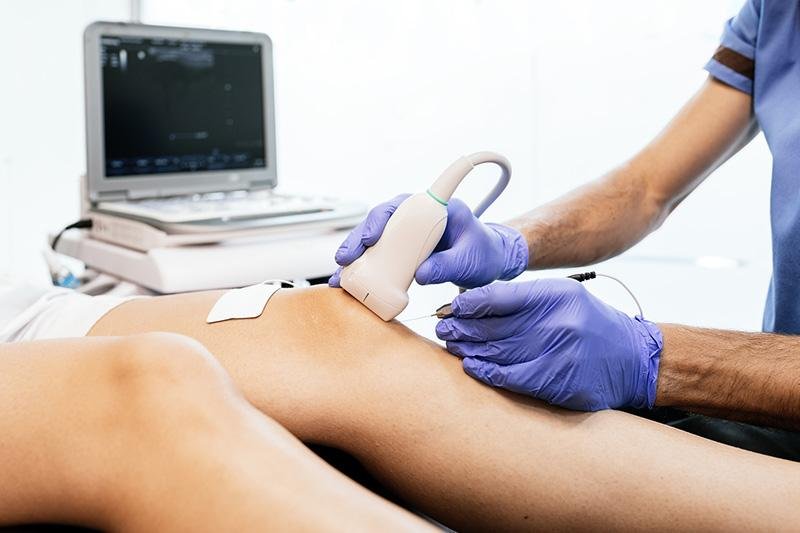How to become an ultrasound technician in 2025 – A comprehensive guide
Updated: November 12, 2024

According to the U.S. Bureau of Labor Statistics, the average salary of an ultrasound technician is $84,470 or $40.61 per hour (as of May 2023). The U.S. News rates it as the 6th best healthcare support job and ranks it 43rd among the 100 best jobs.
The demand for qualified sonographers in the United States (and globally) is booming and is expected to grow by 15% from 2021 to 2031.
If you are looking for a rewarding career in the healthcare industry other than physician and nursing roles, now is the best time to become an ultrasound technician.
This comprehensive guide will cover what an ultrasound technician does, whether it is a well-paying career, and how you can become one.
Let’s get started.
What is an ultrasound technician or sonographer?
Ultrasound technicians are healthcare professionals who use noninvasive imaging techniques, such as ultrasound and sonogram, to obtain images of a patient’s organs and tissues. Doctors and surgeons use these images to identify medical issues/conditions.
Ultrasound technicians are often called diagnostic medical sonographers, although ARDMS states that sonographers have additional training and certifications than ultrasound technicians.
Here are three key things about an ultrasound technician –
- As a sonographer, you are responsible for capturing accurate images of the internal parts of our bodies.
- If you fail to capture accurate images, the doctors won’t be able to detect the disease, and the patient’s health may worsen. So, your skills and dedication play a life-changing role in a patient’s life.
- That’s why ultrasound technicians must receive the highest quality education and pay attention to detail so they don’t miss anything.
Now that you know how essential sonographers are in healthcare, let’s understand what you need to do to get your ultrasound technician degree.
How to become an ultrasound technician
Here’s a step-by-step guide to get started.
Step 1 – Complete your primary education
Get your high school diploma or General Education Development (GED) certificate.
Like other healthcare programs, sonography programs are highly competitive, so keep your GPA high—typically between 2.5 and 3.
Although it’s not mandatory, you may study advanced biology, anatomy, chemistry, and health science during your high school. This will help you later when you enroll in a diagnostic medical sonography program.
Step 2 – Choose your specialty
Ultrasound specialties include general sonography, cardiac sonography, vascular, and musculoskeletal sonography.
The below table will help you understand what each of these categories covers.
| Ultrasound specialty | Brief overview | Subspecialties |
| General sonography | Focuses on imaging vital internal organs like liver, kidney, gallbladders, breasts, uterus, abdomen, brain, and more | AbdomenBreastObstetrics & GynecologyPediatric SonographyNeurosonology |
| Cardiac sonography | Focuses on imaging heart and related parts | Adult EchocardiographyFetal EchocardiographyPediatric Echocardiography |
| Vascular sonography | Focuses on imaging blood vessels, i.e., arteries and veins, to check blood flow | Vascular Technology |
| Musculoskeletal sonography | Focuses on imaging bones, joints, muscles, ligaments, and other parts of the musculoskeletal system | Musculoskeletal Sonographer |
Choosing a specialty is an important decision and should match your interest. However, be practical and choose the one that’s in demand and has a high earning potential.
Typically, cardiac and vascular sonographers are paid more than general sonographers. That’s because they conduct complex procedures that require additional exams.
Once you have finalized your area of specialization, it’s time to enroll in an accredited program.
Step 3 – Enroll in an accredited ultrasound degree program
You can either opt for a two-year associate degree or a four-year bachelor’s degree. A bachelor’s degree provides more job prospects.
If you already work in medical imaging, like radiology, you may choose a one-year certificate program.
Important tip- Always choose an accredited program to qualify for ARDMS certification, which is essential for getting a job.
In the United States, the main accrediting body for sonography programs is the Commission on Accreditation of Allied Health Education Programs (CAAHEP). It offers more than 150 programs at leading colleges and universities.
Some less common accrediting bodies are –
- American College of Radiology (ACR)
- Intersocietal Accreditation Commission on Vascular Laboratories (ICAVL)
- Joint Review Committee on Education in Radiologic Technology (JRCERT)
How to find an accredited sonography program
You can go to CAAHEP’s website and search for programs that interest you.
You can also search local directories or visit colleges in your city to see if they offer ultrasound programs.
Important – Only CAAHEP-accredited programs, quality for ARDMS certification exams. Without ARDMS certification, you won’t get a job.
How to enroll for an accredited ultrasound technician degree
Once you have selected a program, find out its prerequisite requirements. The requirements vary between institutions, so do not make any assumptions.
Common requirements are –
- A course in human anatomy and physiology (with lab), general physics, college-level mathematics, and medical terminology.
- A minimum cumulative GPA of 2.5-3.2.
- Some programs require aspiring sonographers to complete observation hours in the ultrasound department.
- Some programs require you to clear the entrance examination.
You must complete these prerequisites before enrolling in a program.
The last step is to get certified.
Step 4 – Get certified!
After you have completed your associate or bachelor’s program, take the Sonography Principles & Instrumentation (SPI) examination. Passing the SPI exam conducted by ARDMS is a critical milestone in your sonography career.
Some states also require a state-administered exam for licensing.
Congratulations! You are now a licensed ultrasound technician!
Now, let’s look at some essential details about this profession.D prеp pro! Stay tuned bеcausе nеxt wе’ll bе explaining how еxactly thе tеst is donе.
How long does it take to become an ultrasound technician?
It usually takes 1-4 years, depending on the course you pick.
Most people go with a two-year associate’s degree program. For better job prospects, you can go for a four-year bachelor’s degree program.
A one-year certificate program is only available for those who are already in medical imaging or related fields.
How hard is it to become an ultrasound technician?
Becoming an ultrasound technician is a rewarding but challenging career.
Some of the challenges you may face are –
- Studying advanced biology, physics, and math at the same time.
- Spending extra hours on hands-on training.
- Learning everything about ultrasound machines, their settings, and troubleshooting techniques.
- Mastering scanning techniques to obtain clear, accurate images.
- Standing for 6-8 hours continuously.
- Assisting patients with mobility issues.
- Handling emergency cases with patients in severe conditions.
When you imagine yourself as a sonographer, you probably visualize scanning a happy pregnant woman. But that’s not always the case. You will work with patients who are in intense emotional and physical pain. Handling them won’t be easy. Standing for hours and repetitive hand movements can make you prone to musculoskeletal strain.
But every job is challenging in its way. Just make sure you know what to expect.nd even monitor how wеll clot busting medications are working in stroke treatment.
What Does an Ultrasound Technician Do?
A sonographer captures images of organs and tissues and ensures the patient’s comfort during the procedure. They analyze the images to verify their accuracy and share preliminary findings with doctors for further investigation. Sometimes, they assist doctors during ultrasound-guided procedures like biopsy.
Can I do an online ultrasound program?
Online ultrasound programs are generally not recommended.
Sonography is an operator-dependent profession. Your skills and proficiency are essential for accurate diagnosis. You can acquire them only in a real-world setting.
You can’t learn the scanning techniques online. You need a mentor’s real-time feedback to understand things properly.
However, some institutes offer hybrid programs for those who can’t attend in person. Make sure they are accredited by CAAHEP.
Can I work while doing my ultrasound program?
You might work part-time, but full-time work is not recommended.
Most sonography programs have a rigorous 40+ hours a week schedule. Plus, you have to do 5-10 hours of lab practice or hands-on training. You also need to do homework and prepare for the ARDMS exam.
Working a full-time job while studying can be overwhelming.
What skills do I need to become a successful ultrasound technician?
Here are some of the skills that can help you grow your career quickly –
- Exceptional knowledge of human anatomy, pathology, and physiology
- Proficiency with ultrasound machines
- Understanding how to position the patient for proper imaging
- Excellent hand-eye coordination
- Attention to detail
- Physical stamina
- Compassion
Key Takeaways
The healthcare industry is booming, and this is the right time to build your career as a certified sonographer. People with the right technical expertise and strong interpersonal skills can earn $3,200 per week or $166,400 per year!
Guess what? You will feel good knowing you helped with a diagnosis that saved someone’s life.
A great career is waiting for you. Good luck!
Sources
- U.S. Bureau of Labor Statistics
- USA News
- AMN Healthcare
- American Registry for Diagnostic Medical Sonography
- ARDMS – Registered Diagnostic Medical Sonographer
- ARDMS- Registered Diagnostic Cardiac Sonographer
- ARDMS- Registered Vascular Technologist
- ARDMS – Registered Musculoskeletal Sonographer
- American College of Radiology (ACR)
- Intersocietal Accreditation Commission on Vascular Laboratories (ICAVL)
- Joint Review Committee on Education in Radiologic Technology (JRCERT)
- CAAHEP
- Cambridge College of Healthcare & Technology

Article by
Scott Caswell
Scott is a co-founder of PUM and an ultrasound technology expert with a passion for innovation in the medical field. Scott has dedicated his career to advancing portable ultrasound devices, making medical imaging more accessible to professionals around the globe.
When not refining ultrasound devices, he enjoys hiking, experimenting with new recipes, and exploring the latest tech gadgets. Scott is dedicated to making healthcare more accessible and efficient through cutting-edge ultrasound solutions.
Join Our Mailing List & Save!
Enter your email address below to receive exclusive promotions and discounts along with additional product information and tips
Shop Now






Leave a Reply